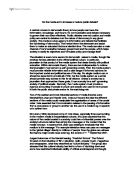Course Code: DA204 TMA 02
Outline how and why audiences have been researched in terms of ‘effects’ and ‘uses’.
Audience research is concerned with explaining how audiences receive, read and react to texts. There are two major conflicting approaches to audiences, one viewing the audience as passive, and the other as active. The critical/radical approach to audiences suggests that audiences passively receive media texts and that viewers are manipulated by media texts into changing or influencing their values and beliefs. A liberal pluralist approach argues that audiences are not influenced by a direct process and that ideas are interpreted by them and the make their own meanings. This approach sees the media as less powerful with the audience having more power over how they use the media. Active audiences do not follow the “Linear Model of Communication” that passive audiences follow. In a linear model of communication the passive audience member receives the media text from the producer and absorbs the information given. Liberal pluralists would argue that communication is not a one-way process and the audience does something with the information once they receive it making them active. Depending on the assumptions gained from these conflicting approaches, whether the media effect the audiences or whether the audience uses the media, will shape the kind of research taken, the questions asked and the methods of the research.
Audience research has been explored to explain the ‘effects’ of media information and how this information may or may not influence behaviour. ‘Effects’ research is usually in reaction to public concern or moral panic about how the media affects people. Effects research assumes the audience is passive, so the viewer, especially vulnerable viewers like children, will absorb media information. The information they receive changes their behaviour and changes or reinforces their values (Sonia Livingston, 2005). To investigate media effects a number of methods have been undertaken. Traditionally experimental research like laboratory research has been prevalent. Experimental research is carried out in a controlled environment to determine how subjects will respond to particular media and effects research is mainly concerned with the effects from viewing television. A good example of this kind of research is a study called the ‘Bobo Doll’ experiment, carried out by Albert Bandura in the 1960s. The assumption was that children learn by conditioning so prolonged exposure to violence on television would lead to children acting aggressively in their everyday lives and this behaviour as an acceptable action. Bandura’s experiment was on groups of children and how the reacted to viewing aggression towards an inflatable doll. One group of children was shown a film where aggression was rewarded, another group was shown a film where aggression was punished and a final group was shown just aggressive behaviour. All the children where then individually monitored in a room, with the same doll they has seen in the film. Only the children that had seen aggression punished in the film did not act violently towards the doll. This study reinforces the vulnerability of children to media and how they passively absorb the behaviour they view causing them to act in similar ways. The experimental approach does not test subjects in their usual lives and results tends not to take into account the attitudes of the subjects before the trials so field-research has been developed as an extension to explore audiences in a less simulated environment. However, this research in general presupposes that the audience is naïve and they do nothing with the information they receive. Effects research seeks to find evidence of audiences as passive and gives simple answers about complex social problems. A liberal-pluralist approach views audiences as actively seeking to make sense of the multifaceted world they live in. We will now explore this approach further.








